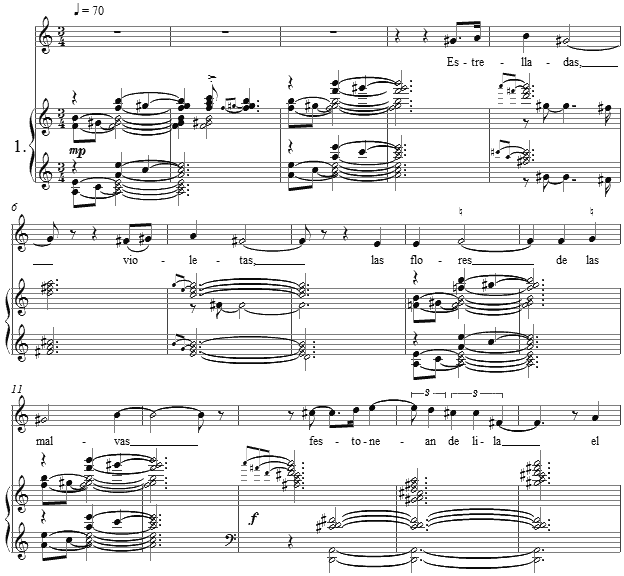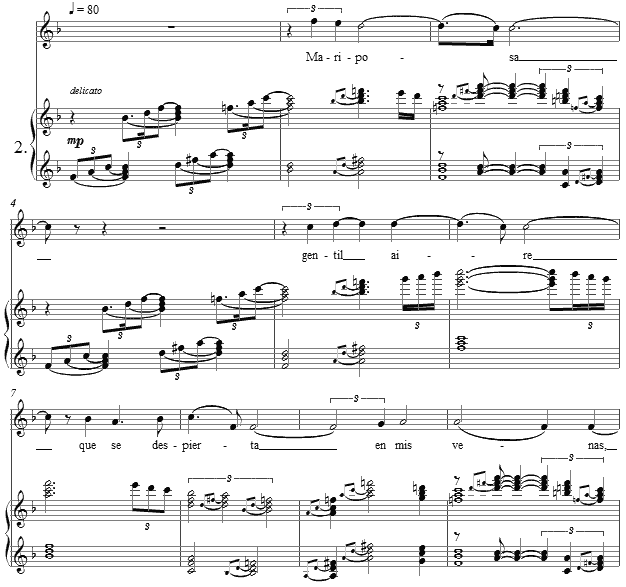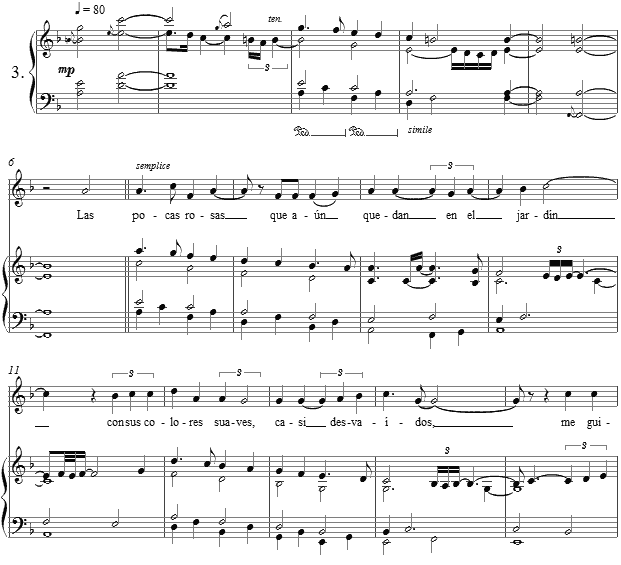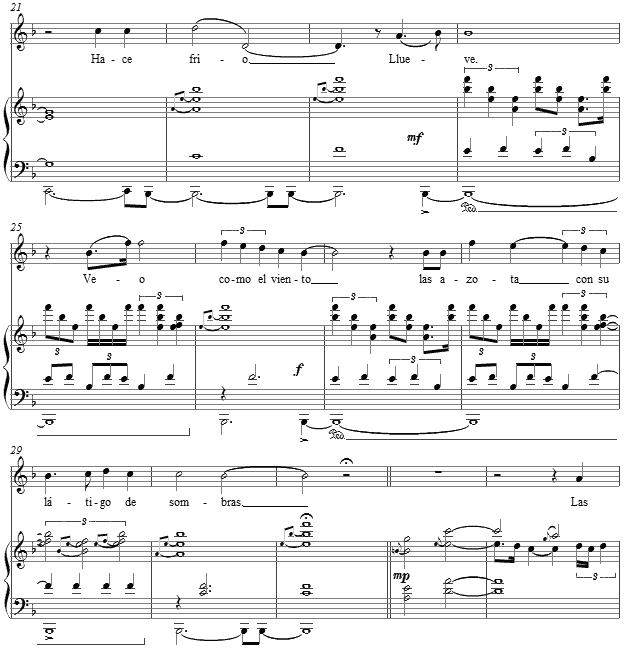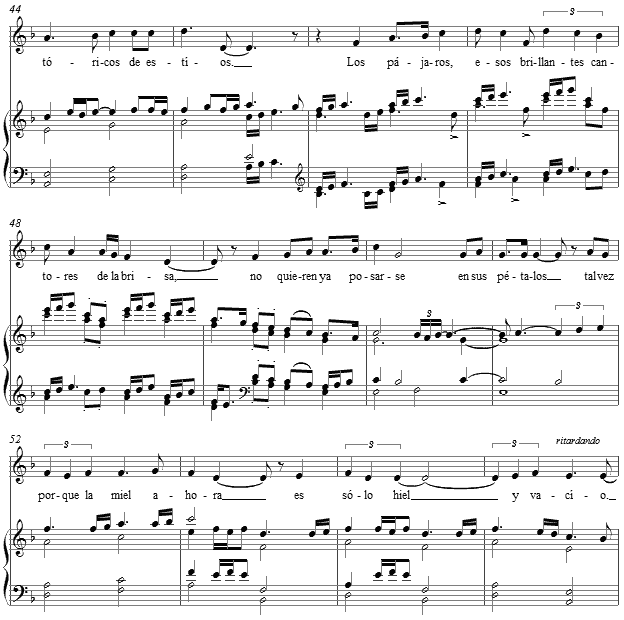Music and Texts of GARY BACHLUND
Vocal Music | Piano | Organ | Chamber Music | Orchestral | Articles and Commentary | Poems and Stories | Miscellany | FAQs
Tres Canciones de Ana María Fagundo - (2008)
for soprano or tenor and piano
for the poet, Ana María Fagundo
i. Malvas en la pradera [ 2 pages, circa 1' 40" ]
Estrelladas, violetas,
las flores de las malvas
festonean de lila el verde de la pradera
compitiendo
en frescura y color
con las rojas amapolas.
Recién estrenada
la primavera
afirma
su esperanzada
y pasajera
plenitud.
ii. A la poesía [ 5 pages, circa 3' 55" ]
Mariposa
gentil aire
que se despierta
en mis venas,
rumor de Dios,
que me encadena,
voz de mi voz,
son de mis soledades.
Aquí estoy
abierta al viento,
mi cuerpo todo
un silencio
de olvidadas aves marineras.
Aquí estoy
en ferviente espera
como el hambre de un niño,
como el campo que aguarda a la primavera.
Errante paloma
-brisa, sol, quimera-
prende mis alas,
aligera mi canto,
rompe la cadena
y el pesado manto
de mi enlutada palabra prisionera.
iii. Rosas en diciembre [ 8 pages, circa 7' 20" ]
Las pocas rosas que aún quedan en el jardín
con sus colores suaves, casi desvaídos,
me guiñan débilmente sus cuerpos perfumados.
Hace frío.
Llueve.
Veo como el viento las azota
con su látigo de sombras.
Las rosas del jardín están ateridas
Aunque sigan diciendo de arreboles
y recuerdos pletóricos de estíos.
Los pájaros, esos brillantes cantores de la brisa,
no quieren ya posarse en sus pétalos
tal vez porque la miel
ahora es sólo hiel y vacío.
Las rosas del jardín aún ondean
sus débiles colores por los aires,
aún, audaces, se yerguen en la penumbra
del eterno diciembre de los ánimos
y pugnan sus pobres pétalos dormidos
hacia otro despertar
de luces y fulgores,
de animoso paso,
de sendas,
de cantos,
de caminos que lleven en sus bordes
primaveras,
alguna retama en flor,
algún hibisco,
el amarillo arrullo de las mimosas,
el imposible olvido.
Las rosas del jardín
están aún hermosas
a pesar de los vientos,
las lluvias
y los agudos granizos del invierno.
Enhiestas sostienen sus colores
contra las sombras del recuerdo
y vivas esperan a marzo con sus brotes.
Las rosas de diciembre no se rinden.
Sources: Malvas en la pradera (Materia en olvido, 2008), A la poesía (Isla adentro, 1969) and Rosas en diciembre (Trasterrado marzo, 1999)
Copyright © 1969, 1999, 2008 by Ana María Fagundo and used by permission
[ 16 pages with cover, circa 12' 55" ]
Ana María Fagundo
Ana Maria Fagundo was born on March 13, 1938 in Santa Cruz de Tenerife on the island of Tenerife in the Canary Islands (Spain). After an idyllic childhood and adolescence in Tenerife, where she trained for a career in business, Fagundo decisively altered the course of her life, accepting a scholarship to the University of Redlands in California. She received a B.A. in English and Spanish literatures in 1963 from the University of Redlands, and earned her M.A. in Spanish literature (1964) and her Ph.D. in comparative literature (1967) from the University of Washington in Seattle. Since 1967 she has been teaching Spanish literature and creative writing at the University of California, Riverside. In addition she publishes the journal Alaluz, devoted to the promotion of Spanish and Latin American poetry, narrative and essay. Alaluz has included the work of internationally known authors such as Vicente Aleixandre, Jorge Guillén, and Ernesto Cardenal, as well as poems by lesser known Spanish and Latin American poets. Of special interest is Fagundo's longstanding interest in women writers, who have appeared abundantly in the pages of Alaluz since its inauguration in 1969. She retired in 2001 and lives in Madrid.
Fagundo has given poetry readings at numerous universities both here and abroad, and her poems have been published in journals throughout the United States, Latin America and Spain. Her poetry has been translated to English. French. Portuguese, Italian, German, Lithuanian, Polish and Chinese. She has graciously allowed these texts to be set to music and to be reproduced on this site, for which I am most grateful.
Conceived for tenor originally and with the kind assistance of tenor, Douglas Duno, I began setting these lovely "flowers" of Ana María Fagundo, coming to see the apt for either tenor or soprano, and perhaps mezzo soprano as well.
The first text is of juxtaposed colors as interpreted through the non-visual medium of poetic words. Adding a layer of sweetly intense harmonic colors to underscore these images was the musical parallel for me, as the opening "Klang" of lilac contrasts against the brighter major seven chords with added tones which follow, the setting ending with the brighter colors following the more complex as "spring affirms its hopeful and fleeting plenteousness."
The second song speaks too of "fervent hope" which would "break the chains" of darker moods and times, like unto the contrast of spring with a preceding winter ("...como el campo que aguarda a la primavera"). The setting therefore begins with triplets in polytonal array, to speak musically of this hope. The vocal line begins on its highest note as the "butterfly" soars in "gentle air" stimulating these brighter "rumors of God." For this within the tonic domain of F major, D major contrasts with B flat major to support the melodic invention of the vocal line. At the coda this song form flies farther afield into a temporary A major, with its complimentary D major against G flat major, before giving way to the original F major.
The last of these settings is the longest, over seven minutes duration. As with the previous two, the emotional theme is one of hope for rebirth as one sees in the coming of each spring after a winter. The image which carries this similar theme now becomes "roses in December," which could be buffeted by winds and rain. These are roses in December "which recall moments of crimson and happy memories of summertime." For this a more somber harmonic gesture opens the setting, and each subsequent section, giving way to a simple, falling theme and an incomplete cadence awaiting resolution in the tonic, F major. A four-part, chorale-like underscores the mentions of roses, in distinction to the other images in the poem.
The winds of winter which "lash" these roses in December are musically pictured with the triplets and repetitive gesture which repeats twice in the setting. After this moment of "wind," the opening gesture returns again with mention of these roses -- survivors of the winds.
Looking forward in time from winter to spring the mention of birds which stand away from "roses in December" are still underscored by a joyous chirping in the tonic. As the poem is in unequal sections, each beginning with the image of the roses, just so each digression to other images follows a new musical picture, each time to return to the opening gesture and a more somber F major which yet also hints of spring and of hope.
The score for Tres Canciones de Ana María Fagundo is available as a free PDF download, though any major commercial performance or recording of the work is prohibited without prior arrangement with the composer. Click on the graphic below for this piano-vocal score.
Tres Canciones de Ana María Fagundo - A4 edition
Tres Canciones de Ana María Fagundo - 8½11 US edition

